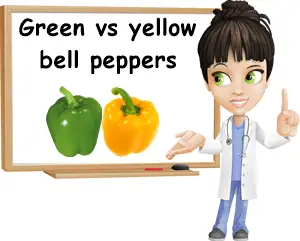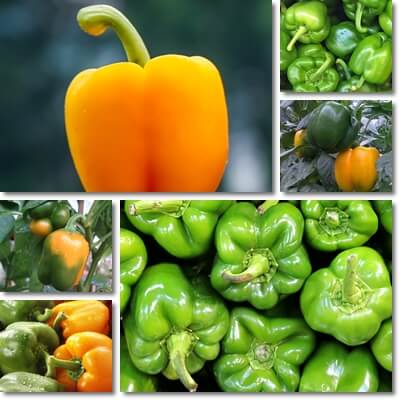The biggest difference between green and yellow bell peppers is, obviously, color. The two colors are the same botanical fruit, just at different ripening stages. Yellow bell peppers are essentially unripe green bell peppers, but not all green bells will turn yellow when ripe. As for nutrition, macro and micro-nutrient profiles and content are fairly similar, the only major differences being the higher vitamin C, B3 and B5, and slightly higher copper and potassium content of yellow bell peppers versus green which are higher in vitamin K and only modestly higher in vitamins B1, B2 and B6.
Are yellow bell peppers green first?
Yes, yellow bell peppers are green first, but as they ripen, they turn yellow. Basically, yellow bell peppers are just ripe green bell peppers. But not all green bell peppers turn yellow when they ripen – some turn orange, some red, others purple, black, a pale green or white and even brown or chocolaty. Some are more than one color, like purple with yellow stripes or yellow with red stripes. And some may stay green. But all bell peppers are initially green, including yellow ones.

Interesting facts
Green and yellow bell peppers are essentially the same fruit, botanically known as Capsicum annuum. They are one of several cultivated varieties of Capsicum annuum peppers. Generally, green bell peppers are unripe, while yellow and other colors are ripe. As bell peppers, they contain non-pungent capsaicinoids which give them a strong peppery flavor, but no pungency. Because they lack pungency, spiciness or hotness, they are also called sweet peppers. Another common name for them is Holland bell peppers, a name that references their extensive cultivation in hothouses in Holland, aka the Netherlands.
A pretty interesting fact about bell peppers is they are botanical fruits (berries actually) but according to their uses in the kitchen, culinary vegetables. And at the same time a spice – when ground into a fine powder, they are a spice known as paprika, or sweet paprika to be more exact. Another interesting fact about them is they ripen on the plant and after being picked, so don’t be surprised if your green bells start turning red or orange or yellow or black after a week or two of sitting in a bowl on the kitchen table. However, allowing them to ripen on the plant will ensure they achieve an optimal nutritional value and a better taste, becoming both sweeter and more flavorful.
What is the difference?
The most obvious difference between green and yellow bell peppers is color. Here’s what that means:
- Green bell peppers are unripe. When they do ripen, they may turn yellow or another color (examples: pale green or white, orange, orange with red stripes, red, purple, purple with yellow stripes, black, brown, lavender).
- Yellow bell peppers are ripe. They are first green, but as they ripen, they turn a uniform golden yellow color.
- Green bell peppers taste bitter, with strong peppery flavors. The less ripe they are, the more intense the bitterness. To avoid extreme bitterness, they should be picked once they reach full size and right before they start to change color, at which point they are more mild tasting.
- Yellow bell peppers have a mildly sweet taste, with strong peppery flavors, but no bitterness. If the color is not uniform and there’s also some green on them, the green parts will retain a mildly bitter flavor. Taste is better is the fruit are allowed to ripen completely on the plant.

- The color in green bell peppers is owed to chlorophyll, a green plant pigment and antioxidant. Green algae, brown algae such as kelp and other seaweed, and green land fruits and vegetables such as green peppers, bells, spinach, parsley, turnip tops, kale, collards, beet greens, mustard greens, dandelion greens are some of the foods highest in chlorophyll.
- The color in yellow bell peppers is owed to carotenoids such as carotenes (beta-carotene, alpha-carotene) and xanthophylls (lutein, zeaxanthin, beta-cryptoxanthin). Most yellow, orange, red and green plant and animal foods contain carotenoids, including green bell peppers.
- Green bells are actually higher in beta-carotene and slightly higher in vitamin A compared to yellow ones (an estimated of 18 micrograms of vitamin A per 100 g of raw green bell peppers versus 10 micrograms of vitamin A for yellow ones).
- Green bells are lower in vitamin C than yellow (the vitamin C content in green bell peppers is 80.4 milligrams per 100 g versus the vitamin C content in yellow bell peppers which is 183.5 milligrams per 100 g).
- Green bell peppers are higher in vitamins B1, B2, B6 and K, versus yellow bell peppers which are higher in vitamin B3 and B5 (almost double the content) and vitamin B9 or folate. Neither colors have any vitamin B12 or vitamin D, and only trace amounts of choline and vitamin E.
- Both colors have about the same mineral content, with similar amounts of calcium, iron, magnesium, manganese, phosphorus, selenium, sodium and zinc. The only major difference is that yellow bell peppers have about double the copper content and roughly 20% more potassium versus green bells. However, mineral content in individual fruits will depend on the mineral content of the soil (minerals are available for uptake primarily from soil).
Conclusion
Whatever color of the two you may like to eat, know that both are healthy foods with overall good nutrition and, as a result, similar health benefits, but also side effects. Differences in nutritional and antioxidant profile are minor: except for the content of vitamin C and vitamins B3 and B5 which is almost double in yellow bells vs green, the two colors provide the same range of essential macro and micro-nutrients and antioxidants and about the same amounts.
